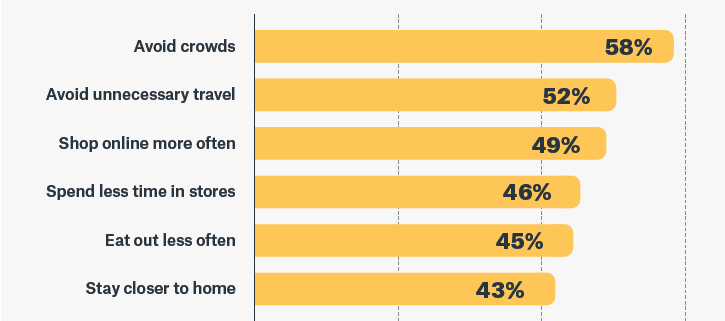In this article:
- Shifting from the office to the home office
- Post pandemic behavior changes
- Keeping employees engaged in an at-home world
- “The rise of a new, remote workforce will disrupt the existing talent ecosystem, making collaboration global. In 2021, it’s essential to retain and attract diverse talent — now more than ever.
- As we continue to adjust to the virtual world, the way we work will continue to evolve as the physical office is replaced by more fluid, home-based workspaces. Companies that plan to survive and succeed need to arm themselves for what’s to come.”
According to new research from Sinch, people worldwide expect permanent changes to daily life and work even after the pandemic has passed. They say that COVID-fueled behavioral changes will persist, and one in three say they’ll work from home more often beyond the end of the pandemic. Employers must now determine how to adapt to a historical change in work environments for professionals worldwide.
The Sinch study, which surveyed 2,890 consumers across 14 countries, documents dramatic shifts in customer behavior and analyzes the features and solutions customers want most from retail brands they trust.
Shifting from the office to the home office
The Sinch survey asked consumers how their lives will be different after the pandemic is over. The findings show a dramatic shift to what some call a “homebody economy.” People say they’ll avoid crowds, shop online more often, and travel less.
Post pandemic behavior changes
People say that even after the pandemic is over, they will continue to limit their activities and movement.

Among the nearly 3,000 consumers Sinch surveyed, one in three say they’ll work from home more often. Since the study did not target consumers who are allowed to work from home, we suspect that ratio is significantly higher among knowledge workers, whose jobs can usually be completed remotely. (In the US, for example, just 40% of jobs can be done at home.)
Response varied widely by country of origin. In Brazil, India, and Singapore, more than half say they will work from home more often, while roughly one-quarter of those from the US and UK say the same. And younger people are more likely to say they will work from home; among Millennials, 43% say this, compared to 25% of younger Boomers (pre-retirement age).

Estimates vary about the size of the shift from in-office to at home. The Harvard Business Review states that pre-COVID, roughly 10% to 12% of Americans worked remotely on a part-time basis, and just 2% did so full time. The US Bureau of Labor Statistics shows that 29% of college graduates worked from home some of the time. Reliable COVID-era statistics are harder to access. A study from Gallup found the number of at-home workers exploded to 70% (part-time or full-time) in late April 2020. A month later, the total working remotely had dropped only 2 points, from 70% to 68%. While these numbers will likely continue to fall after the danger from the pandemic is passed, most expect that working from home will be an option for knowledge workers going forward.
Keeping employees engaged in an at-home world
In the early days of COVID, many employers assumed the work-from-home shift would be short-lived — something that would be quickly reversed once the danger passed. Now that at-home work appears to be a long-term trend, employers must grapple with how to onboard new employees, engage existing ones from a distance, and ensure company communications and data are protected from fraud and hackers.
Vikram Khandpur, chief product officer at Sinch, explains,
“The rise of a new, remote workforce will disrupt the existing talent ecosystem, making collaboration global. In 2021, it’s essential to retain and attract diverse talent — now more than ever.
As we continue to adjust to the virtual world, the way we work will continue to evolve as the physical office is replaced by more fluid, home-based workspaces. Companies that plan to survive and succeed need to arm themselves for what’s to come.”
And rather than view the crisis as a setback, companies should consider it an opportunity. Stewart Butterfield, CEO and co-founder of Slack, says COVID will force a much-needed review and retooling of current practices: “There’s an opportunity to retain the best parts of office culture while freeing ourselves from bad habits and inefficient processes, from ineffective meetings to unnecessary bureaucracy.”

How will employers retain the best parts and weed out the worst?
Engagement
Employee engagement — or the extent to which workers feel connected to a company’s mission, goals, and culture — is a key driver of productivity, innovation, and loyalty … and very difficult to recreate for dispersed teams.
One 22-year-old cyber risk consultant in Los Angeles explained to the BBC, “That camaraderie of hanging out with your co-workers [and] spending time with them at happy hours afterwards... it’s kind of hard to engineer that by yourself.”
And it’s not just social camaraderie that’s missing in a virtual workplace environment. Earning trust and respect at work is harder from a distance. “When you’ve been working at an organization for a long time and then you’re forced to work from home, you do have the benefit of those long-term relationships,” says Amanda Jones, a senior lecturer in human resources management at King’s College, London.
Employers must find ways to replicate these culture-building experiences from a distance. And platforms like Zoom are an imperfect proxy for in-person meetings, says one Boston-based remote worker. “Though Zoom was a great short-term solution, it’s an awkward medium for group conversations because only one person can speak at a time,” she says. “In brainstorming meetings, you can’t have a sidebar chat with the person sitting next to you, or jump in to add a thought while someone is speaking. Zoom doesn’t work for informal, fast-paced, group conversations.”
For these reasons and more, many employers are considering hybrid work-from-home models for the long-term, meaning employees can opt to work from home but must come to the office either weekly or less frequently for face-to-face time with their teams. Mads Christensen, VP at EG Group Procurement & Services, explains,
“We will come back to the office eventually, but not like it was before.”
He says his company is likely to adopt a hybrid work-from-home strategy and “our challenge now is to figure out how to preserve the best parts of in-office working, combined with the best parts of virtual work.
And for the periods when employees are based at home, employers must find tech solutions that support the informal chatter, collaboration, and brainstorming that fuels team cohesiveness. Players like Slack and Microsoft Teams are market leaders, but other niche collaboration solutions show promise.
And even beyond collaboration, HR leaders must think about ensuring their suite of human resources tools are robust enough to make the transition to a work-from-home format. For example, businesses can use AI-driven conversations that supplement the HR function by answering common questions and providing real-time updates on vacation days and sick leave — all through mobile messaging.

Productivity
For years, company leaders were hesitant to allow widespread working from home offices due to concerns about productivity. The pandemic has given companies a chance to test out the hypothesis at scale, and so far it appears productivity hasn’t suffered ... and in some cases has improved under COVID-19.
Technology will help employers assess productivity going forward to ensure these benefits aren’t lost after the novelty of working from home wears off. “Leaders want to know that their employees are working on what’s expected and delivering outcomes. Employees want to make sure their managers know how hard they’re working and that they’re getting things done. And the technology and tools I think help us solve for that trust gap in the middle,” says Karen Mangia, vice president of customer and market insights at Salesforce.
However, the focus should be on “insights, not oversight,” explains Rita Selvaggi, CEO of employee monitoring platform, ActivTrak. “We think there's a huge opportunity for managers to be better enabled as coaches with employees, leveraging the data for that purpose.”
Development & Training
One of the most challenging experiences to recreate at home is mentoring and training in the physical office. One new hire explains, “When you’re remote, you need to be very vocal about the assistance you need and the help you’re looking for. As a new grad and new hire, it definitely affects the way I can learn.” Managers need to take care that employees (particularly younger employees and/or newer employees) have dedicated mentorship and learning opportunities. Since ad-hoc learning is less likely to happen in work-from-home settings, employers must double-down on training and leadership development opportunities for remote workers — both “live” virtual training as well as on-demand options.
And as home-based workers are forced to use more tools and tech platforms to get their jobs done, companies must take care that employees are comfortable with these new ways of working. “Working remotely is a people issue, not a technology problem,” explains Christensen. Christensen says that from Day 1 of the pandemic, the office had the right tools to collaborate remotely, but some team members needed coaching to use the tools effectively.

Elevating security in work-from-home settings
Safeguarding data in a work-from-home environment is also critical. For example, how do employers ensure customer data gleaned from customer support interactions is kept secure? In a study by VMWare, 91% of global corporate leaders say cyberattacks are on the rise since the pandemic began. A different study by Cisco found 61% of IT leaders say the threat has gone up at least 25% since distancing measures and work-from-home policies started.

There is a wide range of solutions to address cyber-security threats; some are sold as one-off applications that join an enterprise tech stack, while others are bundled into all-in-one solutions in areas like customer support or customer experience. These include:
- Robust multi-factor authentication solutions, including options for landlines and sight-impaired customers. (Sinch’s product is flexible about which channels customers use to verify their identity/number, an important consideration given that dedicated messaging apps like WhatsApp have much higher adoption rates than SMS in some markets.)
- Tools to identify and verify incoming calls, such as Sinch’s Flash Call technology.
- Messaging with end-to-end encryption, such as WhatsApp Business API.
- AI-fueled conversations, in which some aspects of customer conversations (e.g., collecting payment information) are completed via mobile forms rather than directly with customer support workers.
For employers, it’s important to treat the pandemic as a messy but powerful opportunity. As Stewart Butterfield, CEO of Slack, shared with the BBC: “We all know that work will never be the same, even if we don’t yet know all the ways in which it will be different. What we can say with certainty is that the sudden shift to distributed work has provided a once-in-a-generation opportunity to reimagine everything about how we do our jobs and how we run our companies.”
Want even more details about post-pandemic behavior changes and where to focus investments for digital transformation? Download any of the industry reports in Sinch’s Customer Experience Transformed research series, available here.



